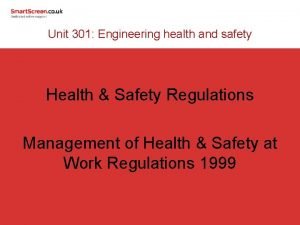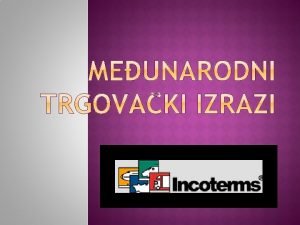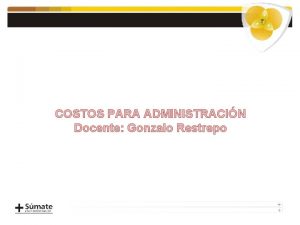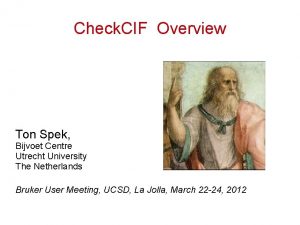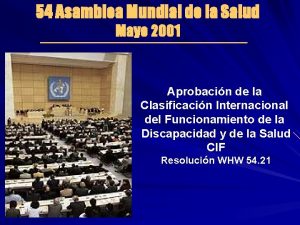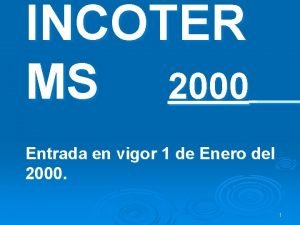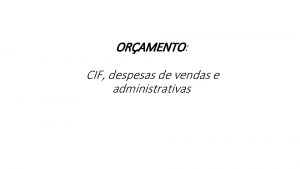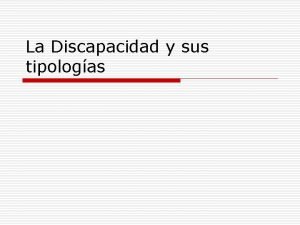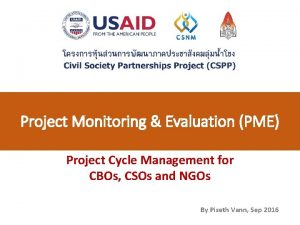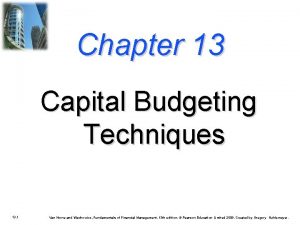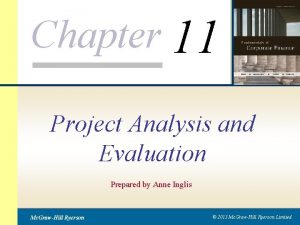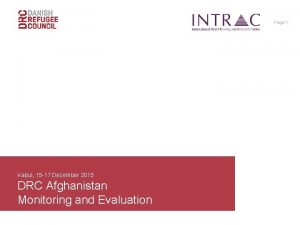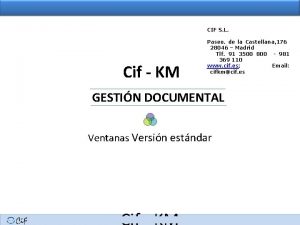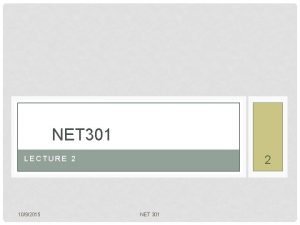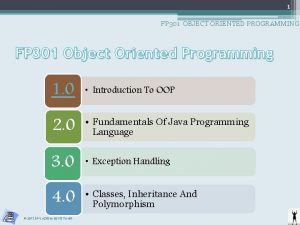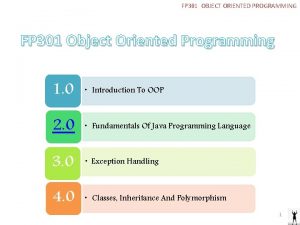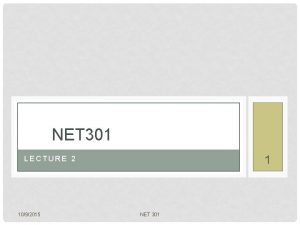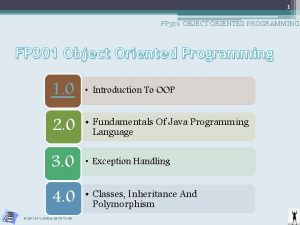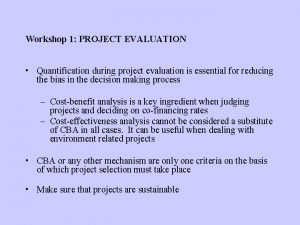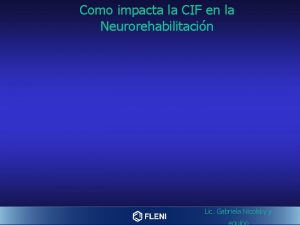CIF 301 Project Evaluation Unit 3 University of








































- Slides: 40

CIF 301 Project Evaluation Unit 3 University of Sunderland CIF 301 Unit 3

Project Evaluation • Introduction – Why evaluate? • To decide a project feasibility • To assess the level of risk – What is evaluated • Strategic issues • technical issues • economic issues University of Sunderland CIF 301 Unit 3

Strategic Issues Some typical strategic issues – some or all of which may apply to a IT project • Objectives – What will the project contribute to the organisations objectives • for example - may it contribute to increasing market share University of Sunderland CIF 301 Unit 3

Strategic Issues • IS plan – Does the proposed project fit into the organisations IS plan • if yes then in which way – How and will the proposed project fit with existing systems • will it replace any – How dose it fit with proposed future developments University of Sunderland CIF 301 Unit 3

Strategic Issues • Organisation structure – Will the project affect the current organisation structure • Management information system (MIS) – Will it complement or enhance existing MIS • Personnel – Skill base, manning, availability, development University of Sunderland CIF 301 Unit 3

Technical Issues • Is it really understood what is required technically – If “no” can this be resolved before the start of the project. – Will any lack of understanding cause changes to the project as it progress University of Sunderland CIF 301 Unit 3

Technical Issues • What functionality is require – Can hardware accommodate this – Is it within the bounds of current available software and/or programming languages University of Sunderland CIF 301 Unit 3

Technical Issues • Do strategic issues place limitations on technical solutions • Cost constraints on technical solutions University of Sunderland CIF 301 Unit 3

Economic Issues • • Cost-benefit analysis Cash flow forecasting Cost-benefit evaluation techniques Risk analysis University of Sunderland CIF 301 Unit 3

Cost-Benefit Analysis • The comparison of estimated costs and benefits • The general question is – will income and other benefits exceed costs – how do the various project options compare University of Sunderland CIF 301 Unit 3

Cost-Benefit Analysis • Analysis is in two stages – Identify and estimate all costs and benefits – Convert costs and benefits into common units • normally monetary units • Costs to be estimated – Development costs – Set-up costs – Operational costs University of Sunderland CIF 301 Unit 3

Cost-Benefit Analysis • Benefits to be estimated – direct benefits • e. g. reduction in staffing levels – Assessable indirect benefits • e. g. reduction in operator errors – Intangible benefits • e. g. improved working conditions University of Sunderland CIF 301 Unit 3

Cash Flow Forecasting • Provides an estimate of the expenditure incurred and the income generated throughout the life of the product. • It is time related • It will provide an indication of when positive and negative cash flow will occur University of Sunderland CIF 301 Unit 3

Cash Flow Forecasting • It is not easy to get things right due to the number of uncertainties • The longer the whole life of the product the more uncertain is the forecast • The increase in aliancing contracts and PPFI have increase the need for improving the accuracy of cash flow forecasting University of Sunderland CIF 301 Unit 3

Cost-Benefit Evaluation Techniques Five techniques will be explored, they are: • Net profit • Payback period • Return on investment (ROI) • Net present value • Internal rate of return University of Sunderland CIF 301 Unit 3

Cost-Benefit Evaluation Techniques • Net Profit • NP = total income - total cost – A very simple technique – Does not consider time element – Of limited use when used in isolation University of Sunderland CIF 301 Unit 3

Cost-Benefit Evaluation Techniques • Net Profit University of Sunderland CIF 301 Unit 3

Cost-Benefit Evaluation Techniques • Payback period – Time taken to break even • i. e. payback initial investment – Projects with short payback periods are preferred nowadays – Does not consider income or expenditure after break even point is reached University of Sunderland CIF 301 Unit 3

Cost-Benefit Evaluation Techniques Net profit + payback period University of Sunderland CIF 301 Unit 3

Cost-Benefit Evaluation Techniques • Return on investment (ROI) – or Accounting rate of return (ARR) – Compares investment required with net profitability • ROI= average annual profit / total investment x 100 • • ROI for project 1 = 10, 000 / 100, 000 x 100 = 10% University of Sunderland CIF 301 Unit 3

Cost-Benefit Evaluation Techniques Net profit + payback period + ROI University of Sunderland CIF 301 Unit 3

Cost-Benefit Evaluation Techniques Net profit + payback period + ROI is Project 1 = 10% Project 3 = 10% University of Sunderland Project 2 = 2% Project 4 = 12. 5% CIF 301 Unit 3

Cost-Benefit Evaluation Techniques • ROI is simple to calculate – this makes it a popular method • But, it has two major problems – It does not consider the time element – The ROI gets compared to bank interest rates • this is not a valid measure as timing and compounding of interest are no considered • This can lead to very misleading conclusions University of Sunderland CIF 301 Unit 3

Cost-Benefit Evaluation Techniques • Net present value (NPV) – considers profitability – takes account of the time element – NPV discounts future cash flows • to current money values • it does this using a percentage rate called the discount rate University of Sunderland CIF 301 Unit 3

Cost-Benefit Evaluation Techniques • NPV a simple example using inflation • £ 100 today = £ 100 • £ 100 today will be worth less in a 12 months time if inflation is 5% • with 5% inflation £ 100 today = £ 95 in a years time • today’s present value of £ 100 gained in 12 months time would be worth only £ 95 if inflation is 5% • £ 100 gained in 5 years = £ 78 today if 5% inflation University of Sunderland CIF 301 Unit 3

Cost-Benefit Evaluation Techniques • NPV a simple example (cont. ) • Another way of considering NPV is that it is the reverse of looking at the value of money from the past. • i. e. with 5% inflation to have the same purchase value of £ 100 5 years ago you would need to spend £ 128 today • NPV considers the value of money in the future with today as the baseline University of Sunderland CIF 301 Unit 3

Cost-Benefit Evaluation Techniques • The formula for net present values of future cash flows is • present value = value in year t / (1+r)t • where r is the discount expressed as a decimal value • and t is the number of years in the future • A simpler method is to use discount tables • present value = value in year t x discount factor University of Sunderland CIF 301 Unit 3

Cost-Benefit Evaluation Techniques • Now calculate the NPV for each of the four projects. University of Sunderland CIF 301 Unit 3

Cost-Benefit Evaluation Techniques Assuming a 10% discount rate, below is the NPV for project 1. Calculate the NPV for projects 2, 3 & 4. University of Sunderland CIF 301 Unit 3

Cost-Benefit Evaluation Techniques • The NPV for all four projects. University of Sunderland CIF 301 Unit 3

Cost-Benefit Evaluation Techniques • Net present value disadvantages – may not be comparable to • other investments • cost of borrowing capital – a solution to this is to utilise Internal Rate of Return University of Sunderland CIF 301 Unit 3

Cost-Benefit Evaluation Techniques • Internal rate of return (IRR) – provides a profitability measure as a percentage return – this directly comparable to interest rate – IRR is used in conjunction with NPV University of Sunderland CIF 301 Unit 3

Cost-Benefit Evaluation Techniques • IRR is the discount rate when the NPV is 0 – e. g. in project 1 the IRR is just over 10% • Calculation of IRR is trail and error when done by hand • IRR can also be estimated using a graphical method • Spreadsheet can often calculate IRR University of Sunderland CIF 301 Unit 3

Cost-Benefit Evaluation Techniques • Using the graphical method University of Sunderland CIF 301 Unit 3

Cost-Benefit Evaluation Techniques • NPV and IRR are not the complete answer – funding, future earning prediction, organisation context must all be taken into consideration University of Sunderland CIF 301 Unit 3

Risk Analysis • All projects involve some form of risk • Project evaluation has risks associated with it • Risk Identification – potential risks are identified, evaluated and ranked • Various analysis techniques available – e. g. Monte Carlo simulation University of Sunderland CIF 301 Unit 3

Risk Analysis • Monte Carlo simulation (MCS) – Simulation … an analytical method meant to model real life scenarios – MCS utilises random numbers for deciding the input variables – Numerous simulations (often several 1000) are then performed utilising randomly generates inputs – The result is a simulated model of the real life system of interest. University of Sunderland CIF 301 Unit 3

Concluding remarks • Project Evaluation – Strategic – Technical – Economic – Risk considerations University of Sunderland CIF 301 Unit 3

Project Selection • In small groups discuss – What are the sort of things that would need to be considered when deciding on whether to build a second tunnel, next to the current Tyne Tunnel, as a means of increasing capacity. University of Sunderland CIF 301 Unit 3

Project Selection • What are the sort of things that would need to be considered when deciding on whether to build a second tunnel, next to the current Tyne tunnel, as a means of increasing capacity. • • Capital costs Operational costs Direct benefits Other benefits Feasibility Associated risks Social and political issues University of Sunderland CIF 301 Unit 3
 Project evaluation in software project management
Project evaluation in software project management What are the 4 c's in health and safety
What are the 4 c's in health and safety Cif ariba
Cif ariba Cif crystallographic information file
Cif crystallographic information file Cif volleyball lineup sheet
Cif volleyball lineup sheet Instituto nacional de la seguridad social (inss)
Instituto nacional de la seguridad social (inss) Cip paritet
Cip paritet Que significa cif?
Que significa cif? Cif qualificadores
Cif qualificadores Modelo cif ejemplo
Modelo cif ejemplo Check cif
Check cif Factores contextuales cif
Factores contextuales cif Modelo interactivo
Modelo interactivo Avanza quimpanor cif
Avanza quimpanor cif Cif incoter
Cif incoter Incoterms 2020 tabela
Incoterms 2020 tabela Orçamento cif
Orçamento cif Hpd cif online form
Hpd cif online form Inmon cif
Inmon cif Actividades y participacion cif
Actividades y participacion cif Classification cif exemple
Classification cif exemple Cif incoterms
Cif incoterms Cih cif
Cih cif Que es la cif
Que es la cif Costo primo formula
Costo primo formula Monterey trail high school football
Monterey trail high school football Karakteristik cif
Karakteristik cif Cpf cif dif definition
Cpf cif dif definition Front room vs backroom data warehousing
Front room vs backroom data warehousing Cifss.org coaches wanted
Cifss.org coaches wanted Unit 10, unit 10 review tests, unit 10 general test
Unit 10, unit 10 review tests, unit 10 general test M&e cycle
M&e cycle Putting it all to bed during project closeout includes
Putting it all to bed during project closeout includes Project evaluation and control
Project evaluation and control Peer evaluation sample
Peer evaluation sample Pbp formula excel
Pbp formula excel Project analysis and evaluation
Project analysis and evaluation Difference between monitoring and evaluation
Difference between monitoring and evaluation Project formulation and evaluation
Project formulation and evaluation Example of monitoring and evaluation in project proposal
Example of monitoring and evaluation in project proposal Objective of evaluation
Objective of evaluation

